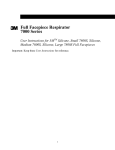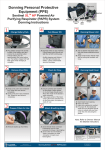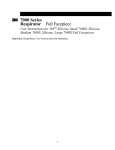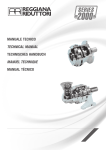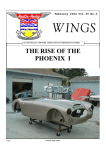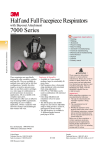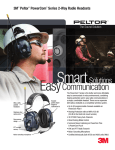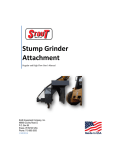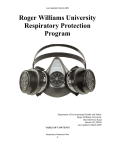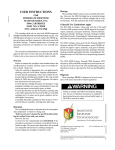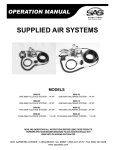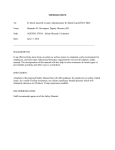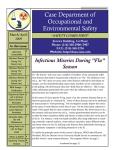Download Half Facepiece Respirator 6000 Series
Transcript
Half Facepiece Respirator 6000 Series User Instructions for 3M™ 6100 (Small), 07024 (Small), 6200 (Medium), 07025 (Medium), 6300 (Large), 07026 (Large) Half Facepieces* Important: Keep these User Instructions for reference. * 07024, 07025, 07026 are catalog numbers only. NIOSH approved 3M™ 6100 (Small), 6200 (Medium), 6300 (Large) Half Facepieces. 1 GENERAL SAFETY INFORMATION Intended Use The 3M™ 6000 Series Half Facepiece Respirators are NIOSH approved and designed to help provide respiratory protection against certain airborne contaminants when used in accordance with all use instructions and limitations and applicable safety and health regulations. This product contains no components made from natural rubber latex. This respirator helps protect against certain airborne contaminants. Misuse may result in sickness or death. For proper use, see supervisor, or User Instructions, or call 3M in U.S.A., 1-800-243-4630. In Canada, call Technical Service at 1-800-267-4414. These User Instructions provide information about facepiece use only. Important information is provided in the User Instructions with each of the air filtration/supplied air systems that are NIOSH certified to be used with the half Facepiece Respirator 6000 Series. Failure to follow User Instructions for the air filtration/supplied air systems being used may result in sickness or death. When in supplied air mode, your employer must provide breathing air that meets at least the requirements of the specification for Grade D breathing air, as described in the Compressed Gas Association Commodity Specification G-7.1-1997 in the United States. In Canada, breathing air systems must be supplied with air, which meets at least the requirements of CSA Standard Z180.1. Failure to do so may result in sickness or death. 2 USE INSTRUCTIONS & LIMITATIONS Important Before use, the wearer must read and understand these User Instructions. Keep these User Instructions for reference. Use For Respiratory protection from certain airborne contaminants according to NIOSH approvals, OSHA limitations, in Canada CSA standard Z94.4 requirements, other applicable regulations and 3M instructions. Do Not Use For Concentrations of contaminants which are immediately dangerous to life or health, are unknown or when concentration exceeds 10 times the permissible exposure limit (PEL) in air purifying mode, 50 times PEL in supplied air mode or according to specific OSHA standards or applicable government regulations, whichever is lower. Use Instructions 1. Failure to follow all instructions and limitations on the use of this respirator and/or failure to wear this respirator during all times of exposure can reduce respirator effectiveness and may result in sickness or death. 2. Before occupational use of this respirator a written respiratory protection program must be implemented meeting all the requirements of OSHA 29 CFR 1910.134 such as training, medical evaluation, and fit testing and applicable OSHA substance specific standards. In Canada, CSA standard Z94.4 requirements must be met. When used in supplied air mode, your employer must supply breathing air that meets at least the requirements of Grade D breathing air in Compressed Gas Association Commodity Specifications G-7.1-1997. In Canada, breathing air systems must be supplied with air which meets at least the requirements of CSA Standard Z180.1. 3. The airborne contaminants which can be dangerous to your health include those that are so small you may not be able to see or smell them. 4. Leave contaminated area immediately and contact supervisor if you smell or taste contaminants or if dizziness, irritation, or other distress occurs. 5. Store respirator away from contaminated areas when not in use. 6. Dispose of used product in accordance with applicable regulations. Use Limitations 1. This respirator does not supply oxygen when used in air-purifying mode. Do not use in atmospheres containing less than 19.5% oxygen. 2. Do not use when concentrations of contaminants are immediately dangerous to life or health, are unknown or when concentrations exceed 10 times the permissible exposure limit (PEL) when used in airpurifying mode, or according to specific OSHA standards or applicable government regulations, whichever is lower. When used as a straight, Type C, continuous flow supplied air respirator, the Assigned Protection Factor is 50 times the PEL or TLV guidelines for half facepiece respirators. 3. Do not alter, abuse or misuse this respirator. 4. Do not use with beards or other facial hair or other conditions that prevent a good seal between the face and the faceseal of the respirator. Time Use Limitations 3 1. If respirator becomes damaged, leave contaminated area immediately and repair or replace the respirator. 2. Replace filters in accordance with the filter Time Use Limitation. (See filter User Instructions.) 3. Replace cartridges in accordance with an established change schedule or earlier if smell, taste or irritation from contaminants is detected. NIOSH Cautions and Limitations The following restrictions may apply. See NIOSH approval label. A– Not for use in atmospheres containing less than 19.5 percent oxygen. B– Not for use in atmospheres immediately dangerous to life or health. C– Do not exceed maximum use concentrations established by regulatory standards. D– Air-line respirators can be used only when the respirators are supplied with respirable air meeting the requirements of CGA G-7.1 Grade D or higher quality. E– Use only the pressure ranges and hose lengths specified in the User’s Instructions. G– If airflow is cut off, switch to filter and/or cartridge or canister and immediately exit to clean air. H– Follow established cartridge and canister change schedules or observe ESLI to ensure that cartridge and canisters are replaced before breakthrough occurs. I– Contains electrical parts which have not been evaluated as an ignition source in flammable or explosive atmospheres by MSHA/NIOSH. J– Failure to properly use and maintain this product could result in injury or death. K– The Occupational Safety and Health Administration regulations require gas-proof goggles to be worn with this respirator when used against formaldehyde. L– Follow the manufacturer's User’s Instructions for changing cartridges, canister and/or filters. M– All approved respirators shall be selected, fitted, used, and maintained in accordance with MSHA, OSHA, and other applicable regulations. N– Never substitute, modify, add, or omit parts. Use only exact replacement parts in the configuration as specified by the manufacturer. O– Refer to User’s Instructions, and/or maintenance manuals for information on use and maintenance of these respirators. P– NIOSH does not evaluate respirators for use as surgical masks. S– Special or critical User’s Instructions and/or specific use limitations apply. Refer to User’s Instructions before donning. S – Special or Critical Use Instructions 3M™ Mercury Vapor Cartridges (6009 and 60929) are equipped with passive 3M™ End of Service Life Indicators (ESLI). The color change indicator must be readily visible when wearing the respirator without manipulation. If you cannot readily see the ESLI, do not use. The mercury vapor cartridges must be discarded when the ESLI changes to the discard color found on the mercury vapor cartridge label; or within 30 days of opening packaging; or when ESLI becomes dirty or damaged; or when odors of vapors or gases become noticeable, whichever occurs first. Mercury vapor has no odor. To assemble 3MTM Dual Airline Combination Breathing Tubes with 3MTM Cartridges/Filters, the facepiece inhalation valves must be removed. 4 If the facepiece is to be used in air purifying mode (without using the 3M SA-1600 or SA-2600 breathing tubes), the inhalation valves must be replaced in the facepiece before use. Cartridge and Filter Selection and Approvals Before using any of these products, the user must read the specific use for, use limitations and warning information in the User Instructions and product packaging or call OH&ESD Technical Service at 1-800-2434630. In Canada, call Technical Service at 1-800-267-4414. Do not exceed maximum use concentrations established by local regulatory agencies. Cartridges/filters are approved as assemblies for use with 3M™ Half Facepiece 6000 Series. For NIOSH approval, refer to approval label. LIST OF PRODUCT 3M™ Half Facepieces Number ****AAD Description 6100 07024 Small 6200 07025 Medium 6300 07026 Large ****AAD part numbers are catalog numbers only. NIOSH approved as OH&ESD part numbers 3M™ Probed Half Facepiece Respirator (for quantitative fit testing only), includes 2091 P100 filters Number ****AAD Description 6100Q Probed Respirator Assembly (Small) 6200Q Probed Respirator Assembly (Medium) 6300Q Probed Respirator Assembly (Large) ****AAD part numbers are catalog numbers only. NIOSH approved as OH&ESD part numbers 3M™ Half Facepieces Respirators (includes 2091 P100 filters) Number ****AAD Description 6191 P100 Particulate Respirator (Small) 6291 P100 Particulate Respirator (Medium) 6391 P100 Particulate Respirator (Large) ****AAD part numbers are catalog numbers only. NIOSH approved as OH&ESD part numbers 3M™ Bodyman and Brake Respirators Number ****AAD Description 07181 Small 07182 Medium 07183 Large ****AAD part numbers are catalog numbers only. NIOSH approved as OH&ESD part numbers 3M™ Accessories and Parts 5 Number ****AAD Description 504 07065 Respirator Cleaning Wipes 601 Quantitative Fit Test Adapter 6889 Exhalation Valve 6893 07144 Inhalation Valve 6895 07145 Inhalation Gasket 6281 Head Harness Assembly 6880 37002 Bayonet Cap Caution Failure to properly dispose of spent cartridges, filters, or respirators contaminated by hazardous materials can result in environmental harm. Handling, transportation and disposal of spent cartridges, filters, or respirators must comply with all applicable federal, state, and local laws and regulations. 3M™ 6000 Series Cartridges Number ****AAD Description NIOSH Approval for respiratory protection against the following contaminants up to ten times the permissible exposure limit (PEL) . 6001 07046 Organic Vapor Certain organic vapors Acid Gas Chlorine, hydrogen chloride, and sulfur dioxide or chlorine dioxide or hydrogen sulfide. Organic Vapor/Acid Gas Certain organic vapors, chlorine, hydrogen chloride, and sulfur dioxide or hydrogen sulfide or hydrogen fluoride 6004 Ammonia/Methylamine Ammonia and methylamine 6005 Formaldehyde/Organic vapor Formaldehyde and certain organic vapors1 6006 Multi-Gas/Vapor Certain organic vapors, chlorine, hydrogen 6002 6003 07047 chloride, chlorine dioxide, sulfur dioxide, hydrogen sulfide), ammonia/methylamine, formaldehyde or hydrogen fluoride1 6009 Mercury Vapor/Chlorine Gas Mercury vapor or chlorine gas 60921 Organic Vapor/P100 Certain organic vapors and particulates 60922 Acid Gas/P100 Chlorine, hydrogen chloride, and sulfur dioxide or chlorine dioxide or hydrogen sulfide and particulates 60923 Organic Vapor/Acid Gas/P100 Certain organic vapors, chlorine, hydrogen 60924 Ammonia/Methylamine/P100 Ammonia and methylamine and particulates 60925 Formaldehyde/Organic Vapor/P100 Formaldehyde and certain organic vapors and particulates1 60926 Multi-Gas/Vapor/P100 Certain organic vapors, chlorine, hydrogen chloride, and sulfur dioxide or hydrogen sulfide or hydrogen fluoride and particulates chloride, chlorine dioxide, sulfur dioxide, 6 hydrogen sulfide, ammonia/methylamine, formaldehyde or hydrogen fluoride and particulates1 60928 Organic Vapor/Acid Gas/P100 Certain organic vapors, chlorine, hydrogen chloride, and sulfur dioxide or hydrogen sulfide or hydrogen fluoride and particulates.2 60929 Mercury Vapor/Chlorine Gas/P100 Mercury vapor or chlorine gas and particulates ****AAD part numbers are catalog numbers only. NIOSH approved as OH&ESD part numbers 1 OSHA regulations require gas proof goggles be worn with half facepiece respirators when used against formaldehyde. 2 3M recommended for use against methylbromide or radioiodine up to 5 ppm with daily cartridge replacement. Note: Not NIOSH approved for use against methylbromide or radioiodine. Service Life of Chemical Cartridges and Filters 6000 series cartridges should be used before the expiration date on cartridge packaging. The useful service life of these cartridges will depend upon the activity of the wearer (breathing rate), specific type, volatility and concentration of contaminants and environmental conditions such as humidity, pressure, and temperature. Cartridges must be replaced in accordance with an established change schedule, or earlier if smell, taste or irritation from the contaminant is detected. Filters must be replaced if they become damaged, soiled or if increased breathing resistance occurs. N-series filters should not be used in environments containing oils. R-series filters may be limited to 8 hours of continuous or intermittent use if oil aerosols are present. In environments containing only oil aerosols, Pseries filters should be replaced after 40 hours of use or 30 days, whichever is first. 3M™ Filters, Adapters, Retainers Note: Only 3M™ Filters approved under NIOSH 42 CFR 84 are to be used with the 3M™ Half Facepiece 6000 Series. Number ****AAD Description 501 07054 Filter Retainer for Filters 5N11 and 5P71 502 Filter Adapter for Filters 2000 Series and 7093/7093C 2071 Particulate Filter, P95 2076HF Particulate Filter, P95, hydrogen fluoride, with nuisance level acid gas relief1 2078 Particulate Filter, P95, 3M recommended ozone protection2, with nuisance level organic vapor/acid gas relief1 2091 07000 Particulate Filter, P100, with nuisance level acid gas relief1 2096 2097 Particulate Filter, P100 07184 Particulate Filter, P100, 3M recommended for ozone protection2, with nuisance level organic vapor/acid gas relief1 7 5N11 5P71 Particulate Filter, N95 07194 7093 7093C Particulate Filter, P95 Particulate Filter, P100 37173 Particulate Filter, P100, hydrogen fluoride with nuisance level organic vapor/acid gas relief1 ****AAD part numbers are catalog numbers only. NIOSH approved as OH&ESD part numbers 1 3M recommended for relief against nuisance levels of acid gases or organic vapors. Nuisance level refers to concentrations not exceeding OSHA PEL or applicable government occupational exposure limits, whichever is lower. Do not use for respiratory protection against acid gases or organic vapors. 2 3M recommended for ozone protection up to 10 times the OSHA PEL or applicable government occupational exposure limits, whichever is lower. Note: Not NIOSH approved for use against ozone. 3M particulate filters must be immediately changed when an increase in breathing resistance is noticed. ASSEMBLY INSTRUCTIONS Note: Make certain 3M™ Inhalation Port Gaskets 6895 are in place on the facepiece bayonet connectors before installing filters, cartridges or breathing tubes. 3M™ 6000 Series Cartridge Assembly 1. Align cartridge notch with facepiece mark, as shown, and push together. (Fig. 1) 2. Turn cartridge clockwise to stop (1/4 turn). (Fig. 2) 3M™ 5N11 and 5P71 Filter Assembly 1. Place filter into 501 retainer so printed side of filter faces the cartridge. (Fig. 3) 2. Press cartridge into filter retainer. It should snap securely into filter retainer. When correctly installed, filter should completely cover face of cartridge. 3. To replace filter, remove retainer by lifting on tab. 3M™ 2000 Series and 7093/7093C Filter Assembly 1. Align opening of filter with filter attachment on facepiece. 2. Turn filter clockwise until it is firmly seated and cannot be further turned. 3. Repeat for second filter. 3M™ Filter Adapter 502 Assembly and Filter Attachment 1. Align adapter over cartridge. Engage front snap by squeezing front of cartridge and adapter together, placing thumbs of both hands over top of adapter and fingers along bottom sides of cartridge. (Fig. 4) 2. Engage back snap by squeezing back side of cartridge and adapter together using the same hand positions. (Fig. 5) An audible click should be heard as each snap is engaged. 3. Place filter onto the filter holder so that filter comes into even contact with gasket. Twist clockwise a quarter turn until it is firmly seated and filter cannot be turned further. Repeat for second filter. 8 Note: The 3MTM Filter Adapter 502, once installed on a 3M™ Cartridge 6000 Series, is not to be removed or reused. Removal or reuse may result in leakage, overexposure, sickness or death. 3M™ 2000 Series and Filters 7093/7093C with 3M™ Filter Adapter 502 Place filter onto the filter holder so that filter comes into even contact with gasket. Twist clockwise one quarter, turn until it is firmly seated and filter cannot be turned further. Repeat for second filter. Note: The 3MTM Filter Adapter 502, once installed on a 3M™ Cartridge 6000 Series, is not to be removed or reused. Removal or reuse may result in leakage, overexposure, sickness or death. 3M™ Supplied Air Systems To meet the U.S. National Institute for Occupational Safety and Health (NIOSH) requirement for minimum (4 CFM/115 lpm) and maximum (15 CFM/424 lpm) air flow, the air control valves approved for use with the 3M 6000 Series Half Facepiece Respirators must be operated within the correct supply pressure ranges and hose lengths. Failure to do so may result in sickness or death. OSHA standard 1910.134 requires that employers provide breathing air which shall “meet at least the requirements of the specification for Grade D breathing air as described in Compressed Gas Association Commodity specification G-7.1-1997.” Failure to do so may result in sickness or death. The 6000 Series Half Facepiece Respirator itself DOES NOT provide Grade D breathing air or air that meets CSA Standard CAN3-Z180.1-00. Assembly of 3M Dual Airline Breathing Tubes 1. Hold the facepiece in front of you so that the 3M logo is facing you. Align the two branches of the breathing tube over the two bayonet mounts on facepiece. For the 3M™ SA-1500 or SA-1600 Breathing Tubes, make sure that 3M logo on breathing tube and on half facepiece are both facing towards you. For 3M SA-2500 or SA-2600 Breathing Tubes, make sure that the 3M logo on breathing tube is facing in opposite direction to 3M logo on half facepieces. (Fig. 6) 3M SA-1500/SA-2500 shown. 2. Twist each branch of breathing tube clockwise a quarter turn until it is firmly seated in the bayonet and cannot be turned further. (Fig. 7 and 8) Do not forcibly overturn as the bayonet could be damaged. 3M SA-1500/SA-2500 shown. 3. Attach airline to approved air regulators per pressure schedules in dual airline operator's manual. Assembly of 3M Combination Dual Airline Breathing Tubes with Cartridges and/or Filters The 3M SA-1600 (front-mounted) and SA-2600 (back-mounted) versions of the 3M dual airline breathing tubes allow use of selected, NIOSH-approved 3M 6000 series cartridges and 2000 series filters. For listing of approved cartridges and filters, reference NIOSH approval label included with 3M dual airline breathing tubes. To assemble 3M dual airline breathing tubes with cartridges and/or filters, do the following: 1. Remove inhalation valves from facepiece and store them so they remain flat. (Fig. 9) 9 2. Attach 3M SA-1600 or SA-2600 breathing tubes to facepiece per the procedures outlined previously. The procedure is identical to the 3M SA-1500 and SA-2500 models. 3. Make a selection of cartridges and/or filters that meets your respiratory protection requirements, and attach to outer bayonets of 3M SA-1600 or SA-2600 breathing tubes. (Fig. 10) 4. Don facepiece per procedures outlined in Fitting Instructions. 5. After being properly fit tested, perform a positive and negative pressure user seal check per procedures outlined in User Seal Check instructions. If you cannot achieve a proper fit, DO NOT enter contaminated area. See your supervisor. 6. Attach airline to approved air regulators per pressure schedules in dual airline operator's manual. Using the 3M Combination Dual Airline Breathing Tubes without Cartridges or Filters To use the 3M SA-1600 or SA-2600 breathing tubes without cartridges or filters, attach a 3M™ 6880 Bayonet Cap to each outer bayonet mount on the breathing tube. When used as a straight, Type C, continuous flow supplied air respirator, the Assigned Protection Factor is 50 times the PEL or TLV. FITTING INSTRUCTIONS Must be followed each time respirator is worn. Note: Do not use with beards or other facial hair or other conditions that prevent a good seal between the face and the faceseal of the respirator. To help maintain a good seal between the face and the faceseal all hair, hoods, or other equipment must be kept out of respirator faceseal area at all times. Donning Respirator 1. Place respirator over your mouth and nose, then pull head harness over crown of your head. (Fig. 11) 2. Take bottom straps in both hands, place them in back of your neck, and hook them together. (Fig. 12) 3. Position facepiece low on the bridge of your nose for optimal visibility and best fit. 4. Adjust top straps first, then lower neck straps by pulling on ends. (Fig. 13) DO NOT pull too tight! (Strap tension may be decreased by pushing out on back side of buckles.) Perform a positive pressure and/or negative pressure user seal check. The positive pressure method is recommended. If you cannot achieve a proper fit, DO NOT enter contaminated area. See your supervisor. User Seal Checks Always check the seal of the respirator on your face before entering a contaminated area. Positive Pressure Seal Check 1. Place the palm of your hand over the exhalation valve cover and exhale gently. If facepiece bulges slightly and no air leaks are detected between your face and the facepiece, a proper fit has been obtained. (Fig. 14) 2. If faceseal air leakage is detected, reposition respirator on your face and/or readjust tension of the elastic straps to eliminate leakage. 3. Repeat above steps until a tight faceseal is obtained. 10 If you cannot achieve a proper fit, DO NOT enter contaminated area. See your supervisor. Negative Pressure Seal Check (with 6000 series cartridges) 1. Place palms of hands to cover face of cartridge or open area of 3M™ 501 Filter Retainer, when retainer is attached to the cartridge, to restrict air flow. (Fig. 15) 2. Inhale gently. If you feel facepiece collapse slightly and pull closer to your face with no leaks between the face and facepiece, a proper fit has been obtained. 3. If faceseal air leakage is detected, reposition respirator on face and/or readjust tension of straps to eliminate air leakage. Repeat above steps until a tight faceseal is obtained. If you cannot achieve a proper seal, DO NOT enter contaminated area. See your supervisor. Note: Use of 3M 501 filter retainer may aid respirator wearer in conducting a negative pressure seal check. Negative Pressure Seal Check (with 2000 series filters) 1. Place your thumbs onto the center portion of the filters, restricting airflow into the breathing tube of filters, and inhale gently. If you feel facepiece collapse slightly and pull closer to your face with no leaks between the face and facepiece, a proper fit has been obtained. (Fig. 16) 2. If faceseal air leakage is detected, reposition respirator on face and/or readjust tension of straps to eliminate the leakage. 3. Repeat above steps until a tight faceseal is obtained. If you cannot achieve a proper seal, DO NOT enter contaminated area. See your supervisor. Negative Pressure User Seal Check (with 7093/7093C Filters) 1. Using hands press or squeeze filter covers toward facepiece and inhale gently. If you feel facepiece collapse slightly and pull closer to your face with no leaks between the face and facepiece a proper seal has been obtained. (Fig. 15) 2. If faceseal air leakage is detected, reposition respirator on face and/or readjust tension of straps to eliminate the leakage. If you cannot achieve a proper seal, DO NOT enter contaminated area. See your supervisor. Negative Pressure User Seal Check with Dual Airline 1. Disconnect airline hose from air control valve. 2. With breathing tube still connected to the air control valve inhale gently. If you feel facepiece collapse slightly and pull closer to your face with no leaks between the face and facepiece, a proper seal has been obtained. 3. For Combination Dual Airline where cartridges or filters are attached perform user seal check as described above under the appropriate cartridge or filter that is being used. 4. If faceseal air leakage is detected, reposition the respirator on your face and/or readjust the tension of the straps to eliminate the leakage and recheck seal. If you cannot achieve a proper seal, DO NOT enter contaminated area. See your supervisor. Note: Before assigning any respirator to be worn in a contaminated area, a qualitative or quantitative fit test must be performed per OSHA Standard 1910.134 or CSA Standard Z94.4. FIT TESTING The effectiveness of a respirator will be reduced if it is not fitted properly. Therefore, either quantitative or qualitative fit testing must be conducted prior to the respirator being issued. Note: Fit testing is a U.S. Occupational Safety and Health Administration (OSHA) and Canadian CSA requirement. 11 QUANTITATIVE FIT TESTING Quantitative Fit Testing (QNFT) can be conducted using a 3MTM 601 Fit Test Adapter and P100 filters such as the 3M™ 2091 or 7093 P100 Particulate Filters. QUALITATIVE FIT TESTING Qualitative Fit Testing (QLFT) with the 3M™ FT-10 or FT-30 Qualitative Fit Test Apparatus can be conducted using any of the NIOSH approved particulate filters. Fit testing should be conducted using the heaviest cartridge, canister, filter or combination that each wearer will use in their work environment. Respirators should also be fit tested while wearing any personal protective equipment (PPE) the wearer may use in their work environment that may affect the fit of the respirator (e.g. hoods, hardhats, safety glasses, hearing protections, etc.). Note: For further information concerning fit testing, contact 3M OH&ESD Technical Service at 1-800-243-4630 or a 3M location in your region. In Canada call Technical Service at 1-800-267-4414. INSPECTION, CLEANING, AND STORAGE Inspection Procedure The 3M 6000 series facepiece must be inspected before each use to ensure that it is in good operating condition. Any damaged or defective parts must be replaced before use. The following inspection procedure is recommended. 1. Check facepiece for cracks, tears and dirt. Be certain facepiece, especially faceseal area, is not distorted. 2. Examine inhalation valves for signs of distortion, cracking or tearing. 3. Make sure that head straps are intact and have good elasticity. 4. Examine all plastic parts for signs of cracking or fatiguing. Make sure filter gaskets are properly seated and in good condition. 5. Remove exhalation valve cover and examine exhalation valve and valve seat for signs of dirt, distortion, cracking or tearing. Replace exhalation valve cover. Cleaning and Storage Cleaning is recommended after each use Do not clean with solvents. Cleaning with solvents may degrade some respirator components and reduce respirator effectiveness. Inspect all respirator components before each use to ensure proper operating condition. Failure to do so may result in sickness or death. 1. Remove cartridges and/or filters. 2. Clean facepiece (excluding filters and cartridges), with 3M™ 504 Respirator Wipes (not to be used as the only method of cleaning) or by immersing in warm cleaning solution, water temperature not to exceed 120˚ F, and scrub with soft brush until clean. Add neutral detergent if necessary. Do not use cleaners containing lanolin or other oils. 12 3. Disinfect facepiece by soaking in a solution of quaternary ammonia disinfectant or sodium hypochlorite (1 oz. [30 ML] household bleach in 2 gallons [7.5 L] of water), or other disinfectant. 4. Rinse in fresh, warm water and air dry in non-contaminated atmosphere. 5. The cleaned respirator should be stored away from contaminated areas when not in use. REPLACEMENT PART INSTRUCTIONS 3M™ 6893 Inhalation Valve Inhalation valves are located on posts at the inside of the facepiece inhalation ports. These valves should be inspected before each respirator use and replaced whenever valves become damaged or lost. 1. Remove existing valve(s) by lifting from post(s). (Fig. 9) 2. Install new valve(s) onto post(s). Be certain valve(s) is fully engaged under all three lugs on post(s), lays flat, and moves freely (spins) on post. 3M™ 6889 Exhalation Valve 1. Remove valve cover assembly from facepiece. (Fig.19) 2. Grasp valve and pull valve stem out from valve seat. (Fig.17) 3. Inspect valve seat making certain it is clean and in good condition. 4. Place new valve over exhalation port and press valve stem into center hole. Be certain the valve is fully seated and spins freely in mount. 5. Replace valve cover assembly. Note: Conduct a negative pressure seal check to ensure exhalation valve is functioning properly. 3M™ 6895 Inhalation Gasket Replacement The closed cell foam rubber gasket is designed to seal the interface between the bayonet attachment inhalation ports on the facepiece and filters/cartridges, dual airline or 3M 201 microphone adapter installed on the facepieces. The gaskets should be inspected with each filter/cartridge change and replaced whenever damaged or if seal integrity is questionable. 1. Remove gaskets from facepiece inhalation port bayonet fittings. (Fig.18) 2. Install new gaskets onto facepiece inhalation port bayonet fittings. Be certain gaskets are in proper position under all three bayonet lugs. 3M™ 6281 Respirator Strap Assembly 1. To remove, disengage upper legs of valve cover assembly from facepiece buttons. 2. Pry or pull valve cover assembly from facepiece exhalation port. (Fig. 19) 3. To install, properly position new strap assembly valve cover over facepiece exhalation port and snap into place by firmly pressing together. 4. Engage holes in upper legs of valve cover assembly with facepiece buttons. 13 FOR MORE INFORMATION In United States, contact: Website: www.3M.com/OccSafety Technical Assistance: 1-800-243-4630 For other 3M products: 1-800-3M-HELPS or 1-651-737-6501 3M Occupational Health and Environmental Safety Division 3M Center, Building 0235-02-W-70 St. Paul, MN 55144-1000 ©3M 2007 98-0060-0036-2/3 14 Fig. 1 Fig. 2 Fig. 3 Fig. 4 Fig. 5 Fig. 6 Fig. 7 Fig. 8 Fig. 9 Fig. 10 Fig. 11 Fig. 12 Fig. 13 Fig. 14 Fig. 15 Fig. 16 Fig. 17 Fig. 18 Fig. 19 15















